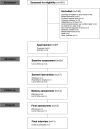What is the feasibility and patient acceptability of a digital system for arm and hand rehabilitation after stroke? A mixed-methods, single-arm feasibility study of the 'OnTrack' intervention for hospital and home use
- PMID: 36171046
- PMCID: PMC9528675
- DOI: 10.1136/bmjopen-2022-062042
What is the feasibility and patient acceptability of a digital system for arm and hand rehabilitation after stroke? A mixed-methods, single-arm feasibility study of the 'OnTrack' intervention for hospital and home use
Abstract
Objectives: Arm weakness is common after stroke; repetitive activity is critical for recovery but people struggle with knowing what to do, volume, and monitoring progress. We studied the feasibility and acceptability of OnTrack, a digital intervention supporting arm and hand rehabilitation in acute and home settings.
Design: A mixed-method, single-arm study evaluating the feasibility of OnTrack for hospital and home use. An independent process evaluation assessed the intervention's fidelity, dose and reach. Amendments to the protocol were necessary after COVID-19.
Setting: Acute stroke services and home settings in North West London.
Participants: 12 adults with a stroke diagnosis <6 months previously (first or recurrent) requiring arm rehabilitation in hospital and/or home.
Intervention: 12 weeks using the OnTrack system comprising arm tracking and coaching support for self-management.
Primary and secondary outcome measures: Recruitment, retention and completion rates; compliance and adherence to the intervention; reasons for study decline/withdrawal.Intervention fidelity and acceptability, evaluated through an independent process evaluation.Patient measures including activity baseline, healthcare activation, arm function and impairment collected at baseline, week 7 and week 14 of participation to assess suitability for a randomised controlled trial (RCT).
Results: 181 individuals screened, 37 met eligibility criteria, 24 recruited (65%); of these, 15 (63%) were recruited before COVID-19, and 9 (37%) during. 12 completed the intervention (50%). Despite COVID-19 disruptions, recruitment, retention and completion were in line with prestudy expectations and acceptable for a definitive trial. Participants felt the study requirements were acceptable and the intervention usable. Fidelity of delivery was acceptable according to predetermined fidelity markers. Outcome measures collected helped determine sample size estimates and primary outcomes for an RCT.
Conclusions: The intervention was found to be usable and acceptable by participants; study feasibility objectives were met and demonstrated that a definitive RCT would be viable and acceptable.
Trial registration number: NCT03944486.
Keywords: neurology; public health; rehabilitation medicine; stroke; telemedicine.
© Author(s) (or their employer(s)) 2022. Re-use permitted under CC BY. Published by BMJ.
Conflict of interest statement
Competing interests: None declared.
Figures





References
-
- WHO . The atlas of heart disease and stroke. Available: https://www.who.int/cardiovascular_diseases/resources/atlas/en/ [Accessed 4 Oct 2019].
-
- Stroke Association . State of the nation: stroke statistics. Stroke Association, 2018.
-
- Patel A, Berdunov V, King D. Current, future and avoidable costs of stroke in the UK. Stroke Association, 2017.
-
- Shaping stroke research to rebuild lives: the stroke priority setting partnership results for investment 2021.
-
- Care Quality Commission . Supporting life after stroke: a review of services for people who have had a stroke and their carers. London: Care Quality Commission, 2011.
Publication types
MeSH terms
Associated data
Grants and funding
LinkOut - more resources
Full Text Sources
Medical
Miscellaneous
